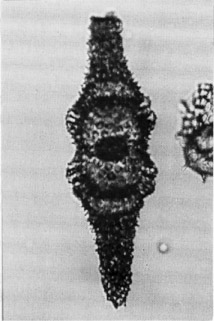 Didymocyrtis
antepenultima (Riedel and Sanfilippo)
Didymocyrtis
antepenultima (Riedel and Sanfilippo) Didymocyrtis
antepenultima (Riedel and Sanfilippo)
Didymocyrtis
antepenultima (Riedel and Sanfilippo)Panarium antepenultimum conditional manuscript name proposed by Riedel and Funnell, 1964, p.311
Ommatartus antepenultimus Riedel and Sanfilippo, 1970, p.521, pl.14, fig.4
Didymocyrtis antepenultima (Riedel and Sanfilippo), Sanfilippo and Riedel, 1980, p.1010
Cortical and medullary shells similar to those of [Didymocyrtis laticonus] and [Didymocyrtis penultima]. [D.laticonus] has no polar caps the distal boundary of the narrow clearer zone between the cortical twin-shell and spongy column is parallel to the distal wall of the cortical shell...whereas [D. penultima] s.s. has caps at least as well developed as its holotype (Riedel, 1957, pl.1, fig.1). [D. antepenultima] includes all forms in which the development of the caps and spongy columns is intermediate between these two (Riedel and Sanfilippo, 1970).
Length of spongy columns 20-90 µm; their median breadth 20-55 µm. Height of polar caps 15-35 µm. Length of cortical shell 90-115 µm; its maximum breadth (including protuberances) 75-115 µm. Breadth of outer medullary shell 25-40 µm (Riedel and Sanfilippo, 1970).
Between the equatorially constricted cortical shell and each polar spongy column is a cap varying in its state of development, between those of its immediate ancestor and descendant, [Didymocyrtis laticonus] and [Didymocyrtis penultima], respectively (Ommatartus antepenultimus in Riedel and Sanfilippo, 1978a).
Westberg and Riedel (1978) restricted the use of this name to "specimens in which the proportion of the height of the polar cap to the length of the cortical shell is > 0.20 and < 0.25."
The variably tuberculate, equatorially constricted cortical shell bears at each end a polar cap surmounted by a spongy column. The most obvious variable within the species is the size of the polar caps. The proportion of the height of the polar cap to the length of the cortical shell increases from 0.20 in early specimens to (but not including) 0.25 in late ones. The spongy column may be nearly as broad at the base as the polar cap, or as narrow as 0.1 times the width of the cap - this extreme is probably a result of dissolution (Sanfilippo et al., 1985).
This species is found in material of middle late Miocene age in latitudes lower than 40°. Specimens with more than one polar cap have been observed in the Indian Ocean and off W. Africa (DSDP Sites 217, 223, 238 and 362). At DSDP Sites 281 and 223, south of Tasmania and in the NW Indian Ocean, respectively, forms with multiple caps and a medullary shell that is circular in outline have been observed.
The evolutionary transition of this species from Didymocyrtis laticonus is approximately synchronous with the lower limit of the Didymocyrtis antepenultima Zone. The evolutionary transition of this species to Didymocyrtis penultima is approximately synchronous with the lower limit of the Didymocyrtis penultima Zone.
D. antepenultima evolved from D. laticonus by an increase in the height of the polar caps, and developed into D. penultima by a continuation of this tendency.
Additional illustrations can be found in Westberg and Riedel, 1978, pl.2, figs.4-5.